|
|
Pot-8-Os

|
|
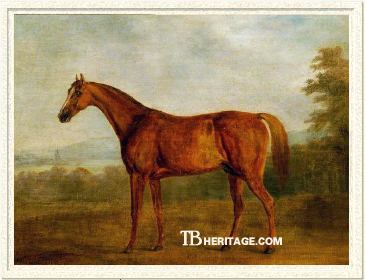 |
|
|
Some turf historians claim Pot-8-Os was the best horse of the eighteenth century. He was certainly an extremely successful racehorse, and later a significant influence on the thoroughbred breed, both in his own time and through today, serving as one of the primary conduits of Eclipse blood to the present in tail-male descent.
He was bred by Willoughby Bertie, (4th) Earl Abingdon; the Abingdon seat had been long-established at Rycote, near Thame, but the fourth earl, who inherited from his father in 1760 while still at Christ Church College, made another Abingdon manor, Wytham, just north of Oxford in Berkshire, the family seat, and it is probably there that Pot-8-Os was foaled. Abingdon was, in addition to being a radical in politics and a skilled flautist, an enthusiastic turfite who won the Jockey Club Plate of 1774 with the racehorse Transit.
Pot-8-Os' fey name is attributed to a story (in various versions) that the young chestnut horse with the blaze in the Abingdon stable was referred to by the stable lads as Potato. When a lad was asked by Abingdon to write the word "potato" on a corn bin, he did so by spelling it "Potoooooooo." The horse first ran under the latter spelling, later shortened.
Pot-8-Os' dam, Sportsmistress traced to Thwaites' dun mare, by the Acaster Turk, who had produced the racehorse, (Beaver's) Driver in 1732 whose primary claim to fame was siring the celebrated Little Driver. Thwaites' dun mare also produced a filly by (Old) Partner, third dam of Sportsmistress. Sportsmistress' dam, the in-bred Golden Locks (1758), was by a fair racehorse, (Portmore's) Oroonoko, considered at the time one of (Old) Crab's better sire sons who commanded one of the highest advertised stud fees in the early 1750s, and who proved, in the long-run, to be a good broodmare sire (also sired Young Lass of the Mill). Sportsmistress' sire, (Warren's) Sportsman (1753), was also only a fair racehorse, although he ran in top company, and we know him today primarily because of his position as damsire of Pot-8-Os. When Pot-8-Os' pedigree is considered, it is interesting to also examine the pedigree of King Fergus (1775), the second of Eclipse's three best sire line sons (Pot-8-Os, King Fergus and Joe Andrews (1778)), whose damsire, Othello (1743, also known as Black-and-All-Black) was a full brother to Oroonoko.
|

|
Pot-8-Os ran successfully for seven years, between 1777 and 1783, most of his races over 4 miles in length. At age 4 he was reasonably successful, placing second twice in Newmarket races for 4 year old colts, third to the aging Chryosite and to the good filly Fleacatcher at Nottingham, and fifth in the Great Subscription Purse at York.
In 1778 he won the 1200 guineas sweepstakes at Newmarket First Spring, beating the 5 year old Grey Robin (by Gimcrack), who was owned by Richard, (1st) Earl Grosvenor. Abingdon, whose enthusiasm for the turf contributed to his financial difficulties, was a sportsman who placed heavy wagers on his horses; during this race he sold Pot-8-Os to Grosvenor for 1,500 guineas, plus any percent of the purse he might win.
Pot-8-Os finished the rest of his moderately successful year, and the rest of his long and highly successful career, under Grosvenor's yellow and black colors.
In 1779 he won a number of races, including a walk-over for the Clermont Cup and the Gold Cup, both at Newmarket, and several purses, subscriptions and sweeps, all at Newmarket, beating such horses as Comet, Pastorella, and Laburnum. The following year he beat King Fergus in the 140 guineas subscription purse at Newmarket Second Spring and Tandem in the Jockey Club Plate at Newmarket, and several other races there, including a walk-over again for the Clermont Cup. He placed third in a sweepstakes to Sir Charles Davers' Woodpecker -- who, as Herod's best son running in these years, was continuously compared to Pot-8-Os, as Eclipse's best son -- but later beat him in a subscription purse at Newmarket.
In 1781 he both won and lost to Woodpecker at Newmarket. He won the Jockey Club Plate there in a walk-over, and also a 400 guineas sweep, plus the Whip, which he took unchallenged. At Newmarket 2st October, he received 85 guineas, "by common consent," from the 140 guineas subscription stakes purse not to start in the race.
The following year he once again won the Clermont in a walk-over, the Jockey Club Plate, beating Buccaneer, and three other races (including a walk-over), as well as the Craven Stakes (beating thirteen mostly younger horses). In 1783, now age ten, he won the Whip at Newmarket Second Spring, but lost a 300 guineas match against the 4 year old Assassin (winner of the previous year's Derby), and a 200 guineas sweep to the younger Anvil. In all, he won thirty-four races.
Retired in 1783, he was installed at Grosvenor's Oxcroft Stud at Balsham, in Cambridgeshire where he got 172 winners of close to £62,000. His fee was initially 5 guineas, which rose to 21 guineas by 1796. In 1797 he was moved to Golding's Upper Hare Park stud, near Newmarket, and he died there in November of 1800, age 27.
Pot-8-Os sired two really top racing sons, Waxy. who won the Derby Stakes in 1793 and ten other races, and later became this sire line's principal progenitor, and Champion, the first horse to win both the Derby and the St. Leger (in 1800). His other notable racing colts included Asparagus (1787) and Tyrant (1799, Derby winner).
|
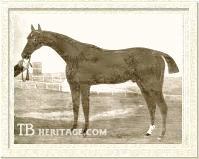
Waxy
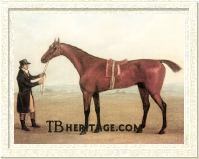
Champion
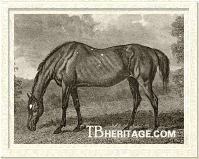
Parasol
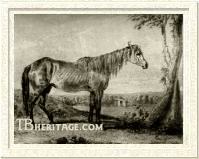
Mandane
| |
The bay Waxy (1790), out of Maria, a Herod daughter, was bred and raced by Sir Ferdinando Poole. He was called "one of the finest formed horses...admirable in all his paces, and of the finest temper..." A successful racehorse, he won the Derby, and races at distances up to 4 miles, including various prestigious King's Plates and the Jockey Club Plate at Newmarket. Poole died in 1804, but waxy remained in the ownership of his successor, Sir Henry Poole for several years, until he was sold in 1807 to the (3rd) Duke of Grafton. In the Grafton stud, crossed with the Highflyer mare Prunella and her daughter, Penelope, by Trumpator, he became the principal progenitor of the Darley Arabian sire line through his enormously influential sons, Whisker (1812, Derby winner), Whalebone (1807, Derby winner), Waxy Pope (1806, Derby winner and later influential sire in Ireland), and Woful (1809). He also got Blucher (1811, Derby winner), from the mare Pantina. He also sired three Oaks winners and some important matrons, including Web (1808, sister to Whalebone and Whisker) and Pope Joan.
Many of his daughters were successful racemares and producers.
CHAMPION (1797), from the great producer Huncamunca, by Highflyer, was bred by Christopher Wilson of Tadcaster, Yorkshire. He won the Derby and the St. Leger, the first horse to win both classic races, and a 300 guineas race over 2 miles at Newmarket. Sold to Lord Darlington, he won several matches and sweeps at Newmarket the following year, breaking down in the running of a match against Lethe. He was sold to Colonel Lumm and was sent to Ireland for stud duty.
TYRANT (1799), out of the Woodpecker daughter Sea Fowl was bred in the Grafton stud; he ran only four times, winning the Craven Stakes at Newmarket and the Derby, called "one of the worst horses that ever won the Derby" by turf writer Nimrod. He had little effect as a sire.
ASPARAGUS (1787), bred and by Lord Grosvenor, raced mostly at Newmarket in high class company. He got some good runners, including Teddy the Grinder, Eliza, and Rhoda, the latter winner of the One Thousand Guineas and numerous cups and plates.
PARASOL (1800), a daughter of the great Prunella and bred in the Grafton stud, was an outstanding mare on the turf, winner of 31 matches, plates, handicaps, and stakes against both sexes in her six year career, including the 1804 Oatlands handicap and Newmarket's Jockey Club Plate in 1805. In the Grafton stud she produced twelve foals, including the good runner and great sire Partisan, Pindarrie (2,000 Guineas winner) and Pastille (Oaks and 2,000 Guineas winner).
|
MANDANE (1800) won one small match at Brighton for her owner and breeder, Thomas Panton and was sold to Yorkshire breeder and sportsman Richard Watt and was installed at his Bishop Burton stud, where she became one of the best broodmares of the early nineteenth century, producing Manuella (Oaks winner, later dam of St. Leger winner Memnon and other good winners), Altisidora (St. Leger winner), Lottery (Doncaster Cup and other distance races, sire of St. Leger winner Chorister), who continued the Tramp sire line, and Brutandorf (Chester Cup, influential sire).
Other Pot-8-Os daughters included the ancestress (1796) of the 1834 racehorse Cardinal Puff; Radish (1787), the grandam of the good race filly Whizgig (1825), and the grandam (1792) of American Eclipse (1814).
-- Patricia Erigero
|
|
|
|

